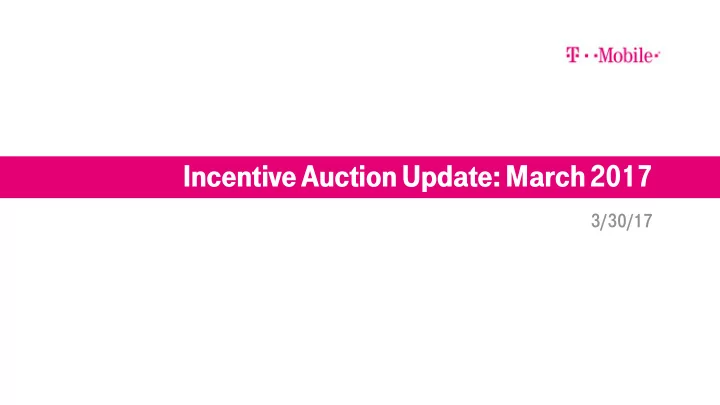

Incentive Auction Update: March 2017 3/30/17 1
2 Broadcaster Transition Process has Started Waiving the prohibited communications rules for broadcasters has significantly accelerated preparation for the post-Incentive Auction Transition Transitioning stations will have more than 5 months to prepare their construction permit application Many broadcasters enthusiastic to receive new state of the art equipment from repacking Vendor work is starting to increase Continued Incentive Auction Task Force outreach to broadcasters is providing clarity and assurance to broadcasters Independent and non-profit broadcasters most in need of transition assistance T-Mobile engaging stakeholders on how to solve transition problems
3 FCC Effectively Optimized The Repack Based on information supplied by licensees and publicly available material, T-Mobile has assembled transition data on more than 1000 broadcaster licenses. Using the FCC’s SAT-based Feasibility Checking software it’s possible to make educated guesses about the status of remaining unknown broadcasters 1. 1. Fewer repack packs – Likely less than 800 full power TV stations will need to be repacked. It appears the FCC’s repacking optimization was better than T-Mobile and other participants in the proceeding anticipated. 2. Fewe 2. ewer towe wers affec ected – Likely less than 700 structures will be touched during the transition 3. 3. Fewer exiting broadcas adcasters – Likely less than 200 broadcasters exiting the UHF band and many of them are moving to VHF or channel sharing. 4. 4. Regional al Repacki acking Appr proach ach – A clear balance between untangling daisy chains with gaining efficiencies again from regional clustering of repacking phases
4 Transition Phases by Region Notes – DMAs without phase assignments have no transitions or no data is available. Hawaii in is phase 1; Alaska will not be repacked as all stations below Ch. 37, Puerto Rico will be in phase 3 & 10
5 Facilitating the Transition: FM Station Collocation Collocated TV and FM broadcasters have various techniques to deal with the technical challenges of working on their antennas Temporary antennas Reduced power Screen suits ERI has indicated they can assemble, tune, QC, and ship an FM Aux Antenna for FM broadcasters in a single day T-Mobile working to determine the number of FM stations collocated with transitioning TV broadcasters
6 Facilitating the Transition: Allow Winners to Relinquish Early Numerous broadcasters who won in the reverse auction and will relinquish licenses are seeking to cease transmission before payment Allowing exiting broadcasters to voluntarily relinquish early would speed the transition: Allows broadcasters to turn off transmitters reducing operating costs Reduces the overall RF emissions on tower sites, making tower work easier and safer Facilitates quicker removal of decommissioned equipment and installation of new equipment The FCC should permit exiting broadcasters to relinquish early so long as they comply with public notification requirements
7 Facilitating the Transition: Process 2nd Window CPs quickly Many broadcasters interested in expanding their coverage in the second window: Example – numerous broadcasters currently transmitting on side mount seeking to replace old top mount analog antenna with new antenna and expand beyond 1% Example – broadcasters using directional antenna seek to move to omni-directional antenna. The second construction permit window should be limited in duration and definitive action taken on CPs quickly Provides additional benefit of speeding resolution for displaced LPTV and translators Stations seeking expanded facilities should not receive a transition deadline waiver except in extreme situations Most transition delays in this instance would be voluntarily imposed Multiple tools available to broadcasters to prevent going dark including temp facilities, reduced power, and channel sharing
8 Facilitating the Transition: Link Station Set Data The Closing and Channel Reassignment PN should contain sufficient information about linked station sets to allow all parties to see how daisy chains are disassembled. Additionally, interference amounts for each station should be provided The CCR should include an Excel or CSV file(s) appendix of auction winners
9 Transition Question: Commencement of Service How does a 600 MHz licensee notify the following licensees when an ISIX analysis requires it: 1. Low power TV – LMS data or CBDS data? 2. TV Translator – LMS data or CBDS data? 3. TV STL link – CBDS data? 4. TV Relay station – CDBS data? 5. TV Translator Relay station – CDBS data? 6. White space database – how to enter in locations, timing? If a licensee has multiple impacted licenses, can they be notified with a single correspondence?
10 Than hank y you ou
Recommend
More recommend